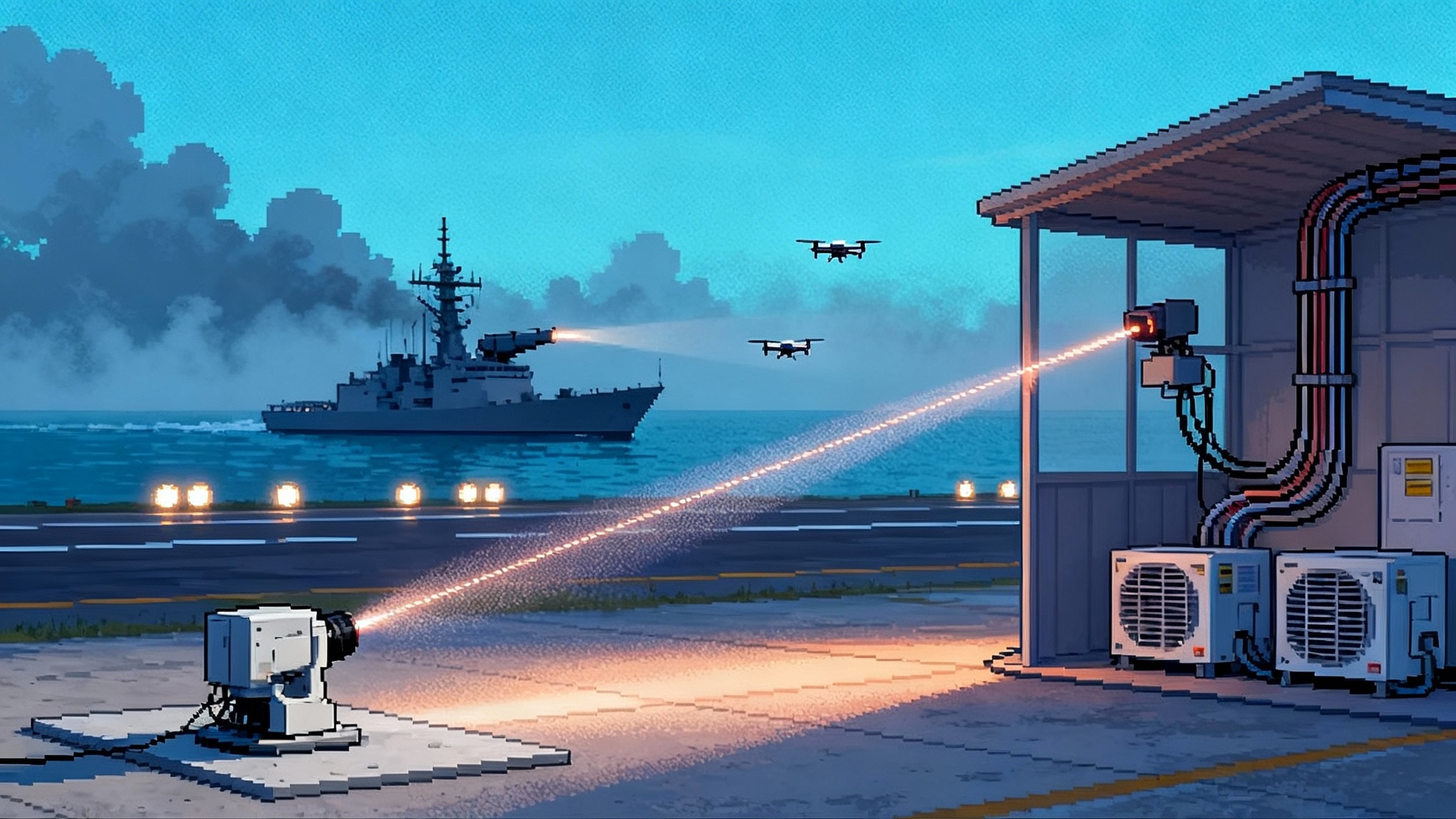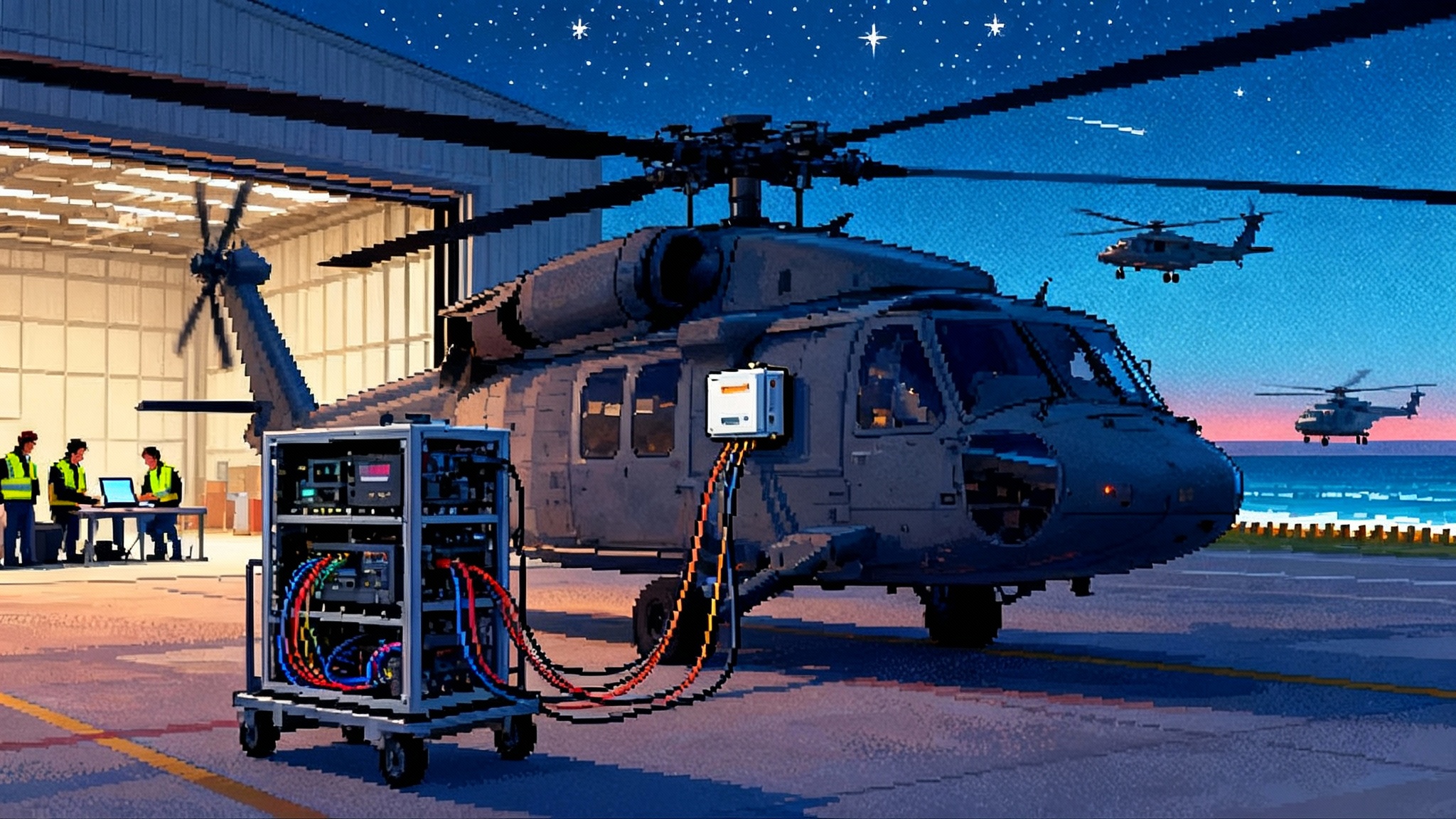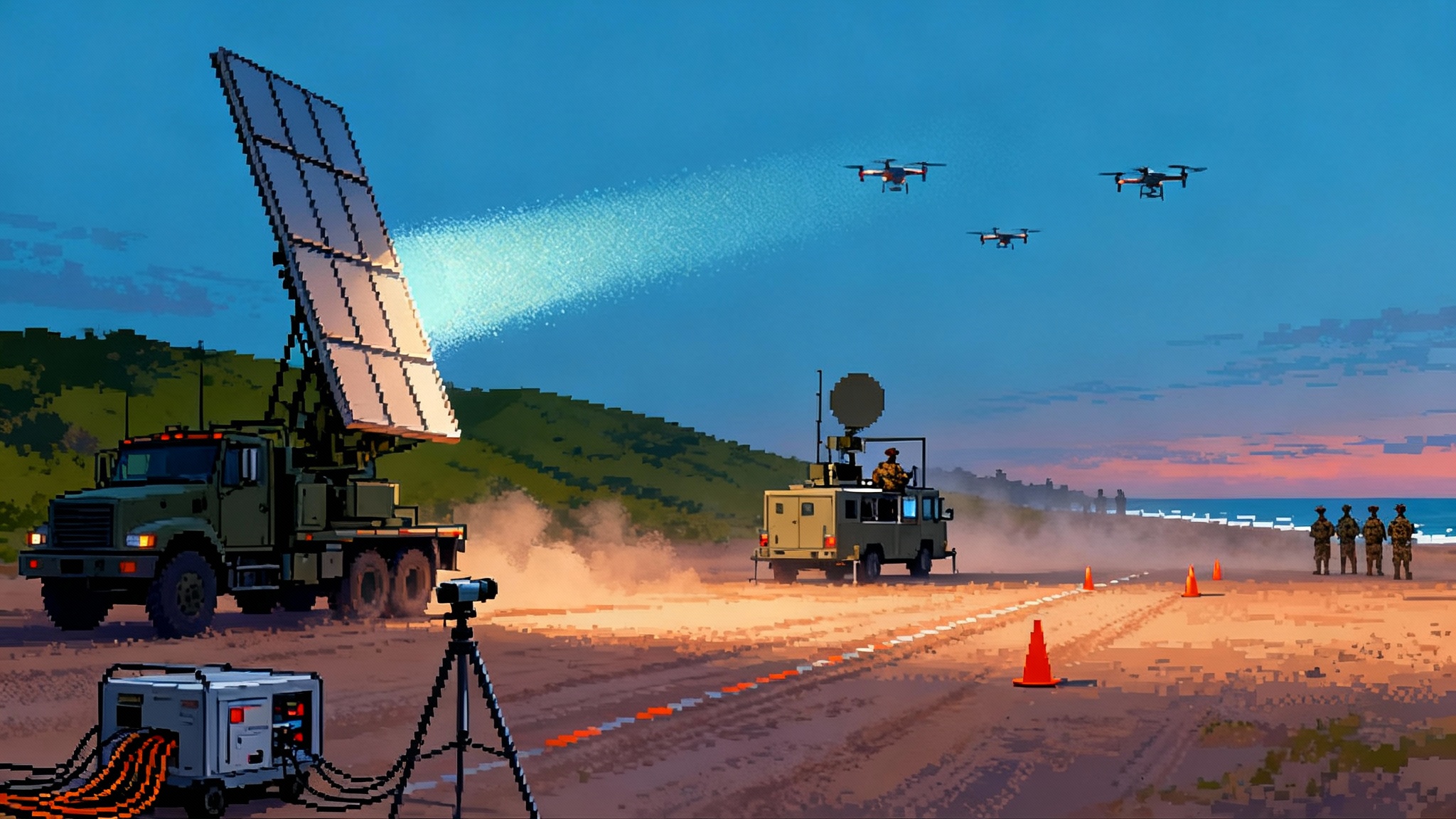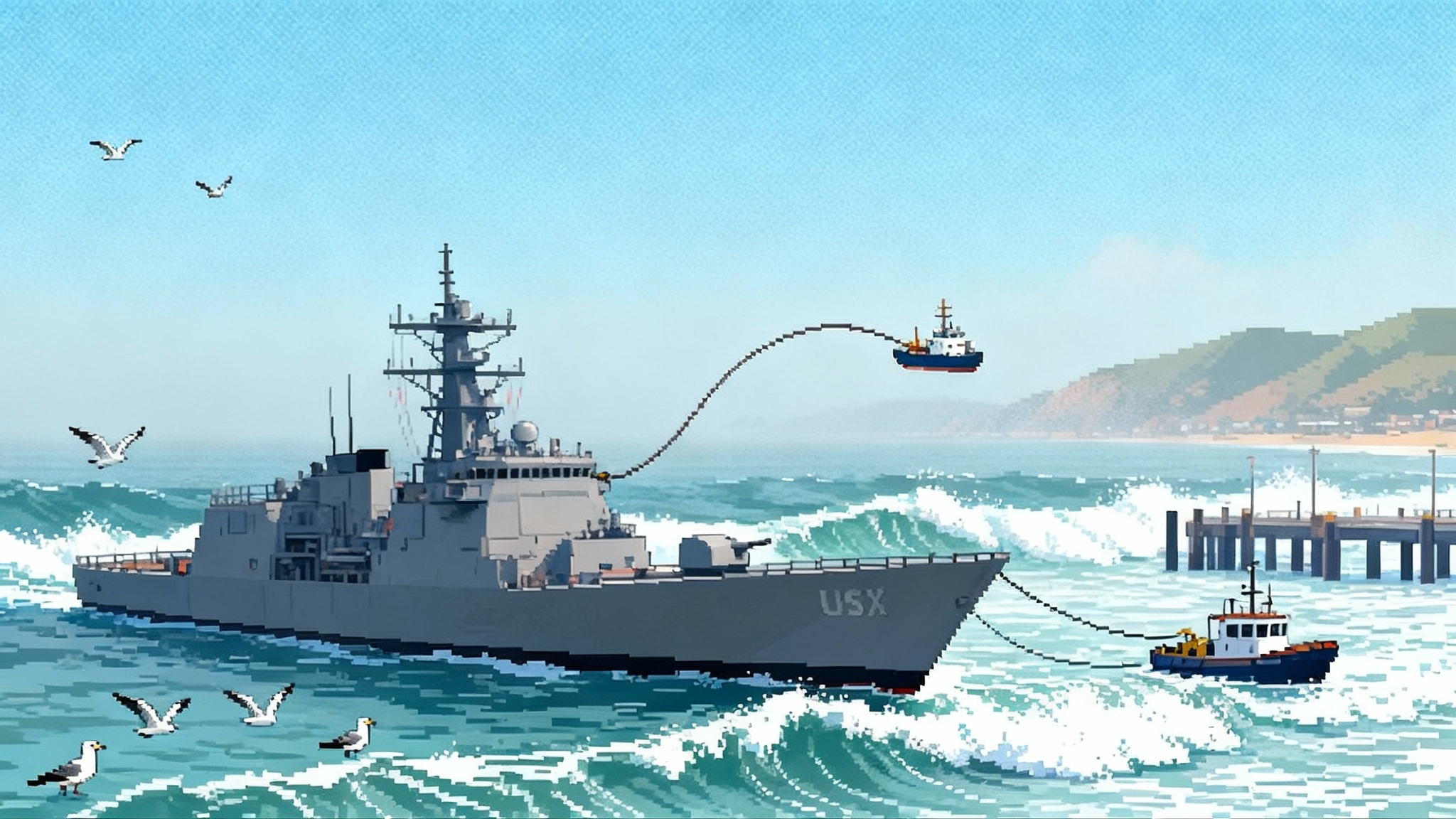Lasers Go Operational: From Demo to Doctrine in Air Defense
Late 2025 is the tipping point. A national laser battery enters service while U.S. ships keep shooting at sea. Dollar-per-shot economics and bottomless magazines are set to reshape base and fleet air defense.

The week lasers stopped being a demo
In late 2025, laser air defense crossed a line. Israel’s government announced its first operational laser battery will enter service this year, a national capability built to burn down rockets, mortars, and drones at a cost of only a few dollars per shot. That program, widely known as Iron Beam, is the first at scale anywhere to move beyond experiments into a standing defensive unit with trained crews and assigned sectors of fire. It is not a science fair any more. It is a weapon with a job to do. Iron Beam ready for use.
At sea, the United States Navy has kept a laser on a destroyer and is still shooting. The HELIOS system aboard USS Preble has been through live testing and continues trials through 2025, the clearest signal yet that shipboard lasers are maturing from episodic demos to routine fleet experimentation that informs real tactics. HELIOS test and plans.
Two steps, taken almost at the same time. Together they change the conversation from could to how.
Why the economics matter
Missile air defense has a math problem. Defenders often spend hundreds of thousands of dollars to knock down a threat that costs a few thousand. Worse, magazine depth limits endurance. A frigate or a battery can only carry so many interceptors. When those are gone, you are done.
Lasers flip that ratio. Once the system is bought and deployed, each shot is essentially the cost of electricity and wear. That is the practical meaning of bottomless magazines. The magazine turns into diesel in a generator, electrons in a battery, and power pulled from the ship. If you can keep feeding power and keep the optics cooled, you can keep shooting. This mirrors the shift toward affordable mass seen in the Coyote counter-drone megadeal.
A useful analogy is a garden hose. A missile is like throwing a bucket of water, you get a lot of effect once, but your bucket empties fast. A laser is the hose on a tap. You still need pressure and flow, but as long as the water runs you can put it precisely where you want, again and again.
What is real versus hype
Let us start with what lasers can do reliably today and in the next few years, and what remains out of reach.
-
Drones and small unmanned aircraft: This is the sweet spot. Drones present thin skins, exposed propellers, and vulnerable optics. A 50 kilowatt class system can blind, burn, or break small drones in seconds, especially inside a few kilometers. That is why ground vehicles, fixed-site batteries, and warships are pushing lasers into their close-in layers.
-
Rockets, artillery, and mortars: Thin-cased rockets and mortar rounds can be heated to failure. Think of applying a blowtorch to a pressurized can. Power on target needs to be higher and dwell times longer than for drones. The practical range band is short, usually within the same base-defense envelope as a counter-rocket system, measured in single digit kilometers.
-
Cruise missiles: This is the hard edge of near-term lasers. Cruise missiles fly faster and have tougher skins. They also often fly low, which means turbulence and clutter. Getting meaningful effect calls for more than 100 kilowatts of power, very good beam control, and clean atmospheric paths. The ambition in several programs is a 300 kilowatt class laser that can defeat a cruise missile’s seeker or damage aerodynamic surfaces fast enough to matter. That will not replace missiles for long-range shots, but it could change the last mile.
-
Ballistic and hypersonic threats: Lasers are not a magic shield. Against reentry vehicles or hypersonic gliders in most weather and most geometries, today’s high energy lasers are not the right tool. The power levels required, the short engagement windows, and atmospheric limits make this a research question, not an operational one.
The hype usually comes from conflating line-of-sight physics with all-weather dominance. Clouds, fog, smoke, and heavy rain scatter and absorb laser energy. Turbulence jiggles the beam. Dust and salt spray degrade optics. All of these are solvable problems in part, but they do not vanish. Lasers will be a layer, not the only layer. Alongside lasers, high power microwave weapons are joining the short-range stack to handle electronics-rich swarms.
The power classes and how they will be used
When people hear 50, 100, or 300 kilowatts, the numbers can feel abstract. Here is a practical way to read them.
-
50 kilowatts: This is the entry point for useful military effect. Vehicle and ship mountings at 50 kilowatts can handle small drones and many Group 2 targets. They can blind sensors and scorch airframes. Expect these to sit close to maneuver units, defend airbases and depots, and ride on ships as a point defense option.
-
100 to 150 kilowatts: This is where rockets, artillery, and mortar rounds start to become viable targets, and where tougher drones can be handled at slightly more forgiving ranges and angles. Expect this class in fixed-site base defense and on larger ships that can spare more power and cooling.
-
300 kilowatts and above: This class begins to threaten cruise missile seekers and airframes in good conditions at tactically useful ranges. The goal is to force the attacker to burn precious salvos at longer ranges, then clean up leakers with a blend of missiles and lasers close in. The United States Army’s high energy laser for its Indirect Fire Protection Capability, supplied by Lockheed Martin as a 300 kilowatt class source, points to this direction of travel for fixed or semi-fixed batteries that protect critical infrastructure.
How they will be employed, practically:
-
Base defense: Lasers will take the bottom of the threat funnel. Small drones and improvised munitions will be assigned to lasers first, saving interceptors for larger targets or for bad weather. Batteries will be paired with radar and electro-optical cueing, plus acoustic or radio frequency detectors for drone swarm awareness. They will not sit alone; they will be stitched into the same command system as kinetic effectors.
-
Maneuver force defense: On Stryker or similar vehicles, 50 kilowatt class lasers will ride with short-range air defense units to thin drone swarms and suppress spotters. They will be used as much for sensor blinding and disruption as for drone kills. Power and cooling are tight on vehicles, so these systems will fight in bursts, then reposition and regenerate.
-
Fleet defense: On destroyers and frigates, lasers will be a new close-in layer. Think of a braided rope of defenses, from long-range interceptors to medium-range missiles, to electronic warfare, then guns and lasers at the end. At sea, lasers shine for endless engagement against buzzing quadcopters and one-way drones, especially when the ship wants to avoid spending a multimillion-dollar missile on a low-end target.
The hard problems left
When lasers move from demo to doctrine, the remaining problems stop being about whether the physics is real and start being about how to field and sustain.
-
Power: Lasers convert electrical power into coherent light plus heat, and they need a lot of it. On vehicles, that means oversized generators and battery buffers. On ships, it means tapping into the combat system’s electrical plant without starving propulsion or sensors. A practical rule for planners is to think in megawatts of installed electrical capacity for a 300 kilowatt class continuous laser, since no real system is perfectly efficient.
-
Thermal management: Every watt not turned into light becomes heat. That heat must go somewhere. Fixed sites can use chilled water loops and big radiators. Vehicles rely on heat exchangers and phase change materials. Ships have seawater, which helps, but fouling and corrosion make design tricky. Thermal storage tanks that act like flywheels for heat will be one of the most important hidden components of operational lasers.
-
Beam control: Hitting a five inch target at several kilometers with a spot of light is not trivial. The atmosphere bends and jitters the beam. Gimbals must be smooth, mirrors clean, and software fast. Adaptive optics that measure the air ahead of the beam, then pre-distort the wavefront so it arrives tight, are migrating from astronomy into weapons. Expect this upgrade path to matter as much as raw power.
-
Weather tactics: Commanders will need weather briefs that are much more specific than cloudy or clear. Layers of haze and humidity at certain altitudes can kill range. Adversaries will time launches for fog banks and rain squalls. The answer is to pair lasers with all-weather guns and missiles, and to adjust engagement zones dynamically as the atmosphere changes during a battle. Tactics will evolve to hold targets in the beam longer or shift aim points when the air is dirty.
-
Command and control integration: Lasers cannot become the default layer until they are just another effector in the network. That means the same track numbers, the same rules of engagement, the same doctrine for who shoots first and who holds fire. It also means the combat system needs to understand laser dwell time and predicted outcomes, not just missile flyout times. The quickest way to kill confidence in a new weapon is to make the operator guess. Integration solves that.
-
Sustainment and cleanliness: Dust, smoke, salt, and grime on optics reduce power on target. Unlike missiles, which are sealed until use, lasers are machines that need cleaning and calibration. Crews will learn to treat optics like jet turbine blades. Expect a new routine of boresight checks, mirror swaps, and filter changes built into daily operations.
What changes for base and fleet air defense
Lasers change the spending curve and the endurance curve. That is the core of the doctrinal shift.
For bases, the new playbook looks like this. Put lasers on the perimeter with clear fields of fire and dedicated power. Feed them tracks from the same sensor network as your kinetic systems. Give them priority on small drones, improvised rockets, and mortar rounds. Make sure each laser battery has a weather-informed engagement map, so the duty officer knows at a glance whether today is a laser-first day or a missile-first day. Train crews in target prioritization that suits lasers, such as burning propellers on the lead drones in a swarm to create a pileup.
For ships, the playbook is similar but mobile. Start engagements at long range with missiles to cut the number of leakers. Shift to lasers as range closes to keep ammunition in reserve. Use lasers to blind and harass surveillance drones before they can cue anti-ship missiles. In peacetime, do not waste expensive missiles on nuisance drones in crowded waters. Keep the shot costs low and the readiness high.
The side effect is strategic. Adversaries who relied on massed cheap drones to exhaust magazines will find that strategy less reliable. They will adapt with smoke, decoys, and mixed salvos that try to soak up laser dwell time. That is healthy. It moves the offense defense race back onto a footing where both sides spend roughly similar amounts to gain an edge.
The 2025 to 2029 roadmap
Here is what to watch over the next four years, and what would accelerate the shift from niche to default layer.
-
Scaling and standardization: Expect more 100 to 150 kilowatt class systems at fixed sites, where power and cooling are manageable, and initial 300 kilowatt class systems to harden into programs with repeatable designs. Standard power modules that snap together like server racks will make upgrades routine. The industrial supply base for high efficiency diode pumps and fiber amplifiers will be a rate limiter, so multi-year buys that smooth demand will help.
-
Allied adoption: Israel’s fielding creates demand signals. The United Kingdom is on a path to place DragonFire on Royal Navy ships in the second half of the decade. Germany’s year-long at-sea demonstrator proved maritime integration can work, and there is political momentum to buy a productized variant. The United States Army is pushing a high energy laser into its Indirect Fire Protection Capability for fixed sites, while its Stryker-mounted lasers mature for maneuver brigades. Expect Japan and Italy to move next with shipboard point defense lasers, helped by their robust shipbuilding sectors.
-
Ship fit packages: The big win at sea is to make the laser an appliance. A topside unit that bolts to standard foundations, with a below-decks power and cooling skid that ties into existing ship services, will reduce integration costs and unlock retrofits. When a destroyer can get a laser during a regular maintenance availability, adoption goes up.
-
Thermal storage: Think of this as a battery for heat. Phase change materials and high surface area heat exchangers let a laser fire hard for a short period, then dump heat slowly into seawater or ambient air. This matters for defeating a short, intense drone swarm without waiting for cooling to catch up. Fielding practical thermal storage is the surest near-term way to turn promising lab power levels into real kill chains.
-
Artificial intelligence cueing and scene understanding: Lasers need exquisite pointing and prioritization. Automated cueing that fuses radar, passive radio frequency detection, and electro-optical tracks will shrink the time from detect to burn. Scene understanding models, trained on cluttered backgrounds and drone signatures, will help aim points land on propellers, wings, or sensor apertures immediately. That reduces dwell time, which is the currency of laser air defense.
-
Weather-informed doctrine: Integrate atmospheric sensors and nowcasts into command and control so operators see a live heat map of laser effectiveness across the sector. If haze is thick in the valley but the ridge line is clear, commanders can shift shooters and adjust engagement priorities. This is a software and training problem, not a physics problem, and it can be solved quickly once leaders make it a requirement.
-
Testing that mirrors saturation: The fastest way to learn is to fight the way adversaries attack. That means more tests that pit lasers against complex, mixed salvos. Drones with smoke generators, low-flying cruise missile surrogates, and rockets in bad weather. Data from these trials should flow directly into beam control software updates and crew procedures.
-
Interchangeable effectors in the fire control loop: Treat the laser as just another effector with its own engagement envelope. The fire control system should assign targets to a missile, a gun, or a laser based on probabilities of kill, dwell estimates, and weather weighting, then update that decision live as conditions shift. This closes the loop between promise and practice.
These near-term moves sit beside longer-range efforts like the hypersonic defense sprint plan, which tackles threats that lasers are unlikely to handle alone.
Actions to take now
-
If you run a program office: Buy the boring parts first. Lock in diode pumps, fiber amplifiers, and thermal exchangers with multi-year contracts so your vendors can invest in capacity. Standardize interfaces so you can swap in higher power modules as they mature.
-
If you command a base or a ship: Update your defense design. Redraw sectors with laser lines of sight and weather constraints in mind. Preplan tactics for mixed salvos that will try to saturate dwell time. Put cleaning and calibration of optics into the daily routine.
-
If you set policy: Fund the test events that make doctrine. Require saturation trials and mixed-threat runs, and publish the lessons across services and allies. Move lasers into the same procurement lanes as guns and missiles by insisting on modularity and common interfaces.
The bottom line
The late 2025 fielding of a national laser battery and a steady drumbeat of shipboard shots mark a genuine threshold. Lasers will not replace missiles and guns, and they do not make weather vanish. They do something more valuable. They rewrite the economics and endurance of the close-in fight. When power, thermal, and beam control are treated as logistical items rather than exotic research problems, lasers become the default layer for the cheapest and most numerous aerial threats.
In 2029, the best defended bases and ships will not brag about a single wonder weapon. They will quietly run a balanced stack where missiles reach far, guns bite hard, and lasers keep the small stuff away hour after hour. That is not hype. That is how doctrine is born.








